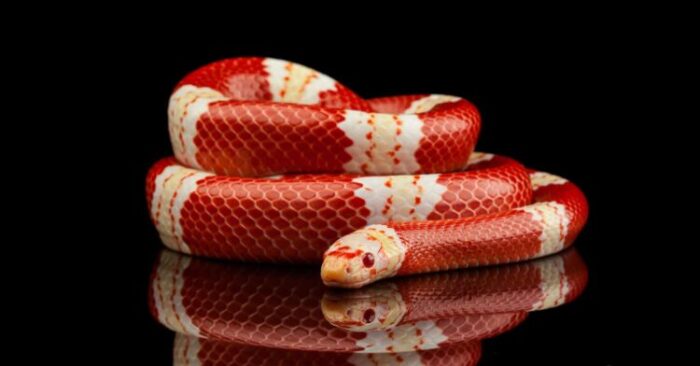For reptile lovers, few pets capture the imagination quite like exotic snakes. From their colorful scales to unique behaviors, exotic snakes make for rewarding yet challenging pets that allow their owners to connect with nature in an intimate way. However, proper research and preparation are crucial before bringing one of these fascinating reptiles home. In this article we talk about 10 Exotic Snakes Perfect for Reptile Enthusiasts in 2024.
Read on to learn what makes each of these snakes perfect for intermediate to advanced reptile keeping enthusiasts.
Table of Contents
Ball Pythons: The Classic Exotic Pet Snake
The ball python (Python regius) is arguably the most popular pet snake in the world. Native to West and Central Africa, these docile constrictors stay relatively small, maxing out at 5 feet long. Ball pythons are easy to handle and make excellent starter snakes.
What makes ball pythons truly special is their incredible variety of morphs. Through selective breeding, ball pythons now exhibit an incredible spectrum of colors and patterns like pied, albino, spider, and more. Their calm demeanor, manageable size, and morph diversity make ball pythons a must-have exotic pet snake.
Corn Snakes: Great for Beginners
Another classic starter exotic is the corn snake (Pantherophis guttatus). Named for their affinity for hiding in corn cribs, corn snakes make hardy, easy-to-care-for pets. Their average adult size of 4-5 feet strikes a nice balance – they’re small enough to easily handle but large enough to watch grow.
Add in their calm temperament, simple care needs, and stunning array of color morphs, and it’s easy to see why corn snakes are beloved by novices and experts alike. Their only downside is that they are proficient escape artists! A secure, well-fitted enclosure is a must.
Kingsnakes: Defeating Dangerous Prey
Get ready for a larger, more powerful snake with kingsnakes like the California kingsnake (Lampropeltis californiae). Growing over 6 feet long, these constrictors are adept hunters in the wild, feeding on other snakes (even rattlesnakes!), rodents, birds, lizards, and eggs.
Their defensive nature and taste for snakes and eggs mean kingsnakes may not be the best fit for a mixed-species vivarium. However, their size, strength, and legendary feeding response make them exciting captives for dedicated herpetoculturists. Plus, who wouldn’t want a snake that eats rattlesnakes!
Rosy Boas: Placid and Pink Beauties
On the opposite end of the temperament spectrum, the rosy boa (Lichanura trivirgata) is one of the most docile snakes in existence. Their petite 2-4 foot adult length coupled with their extremely calm disposition makes rosy boas an excellent choice for novice herpers. These placid pink snakes rarely bite and make great hands-on pets.
Beyond their sweet temperament, rosy boas also feature subtle yet beautiful patterning down the length of their bodies. Their care needs are straightforward compared to other exotics – as long as you provide proper temperatures and humidity, rosy boas will thrive.
Sand Boas: Patient Ambush Hunters
Looking for a smaller burrowing species? Look no further than Kenyan sand boas (Eryx colubrinus). Only reaching 2-3 feet as adults, these small yet stocky boas are primarily crepuscular and spend much of their time buried beneath the substrate waiting to ambush prey. When exposed, their beautiful patterns featuring alternating saddles of color stand out prominently against the sand.
Despite their defensive nature in the wild, sand boas rarely bite and make quite docile captives. Their simple care needs, relatively tiny size, and incredible pattern diversity make sand boas exceptional exotic pets. Just be sure to provide plenty of substrate for burrowing!
Emerald Tree Boas: Arboreal Gems
If colorful ground snakes aren’t your style, meet the emerald tree boa (Corallus caninus). As their name suggests, emerald tree boas spend their lives high up in the rainforest canopy stalking birds and other tree-dwelling prey. Heavy bodied and averaging 6-8 feet in length, emerald tree boas are a bold, advanced species requiring specialized care and housing.
What they lack in ease of care, emerald tree boas make up for in sheer magnificence. Their iridescent green scales shine brightly in the light, showcasing incredible ruby red eyes. These snakes command attention with their graceful movements and incredible beauty. Just be prepared to provide ample climbing opportunities!
Brazilian Rainbow Boa: A Shimmering Constrictor
Similar to the emerald tree boa but with less demanding care requirements is the Brazilian rainbow boa (Epicrates cenchria). Growing 5-7 feet long, rainbow boas showcase incredible iridescence as their scales refract ambient light into shimmering rainbows down the length of their bodies. This mesmerizing effect alone is worth the price of admission for dedicated reptile enthusiasts.
In addition to their hallmark iridescence, Brazilian rainbow boas also feature intricate circular and diamond-shaped patterns in hues of orange, red, black, and yellow. When combined with their ample size and considerable strength, the Brazilian rainbow boa’s looks and brawn make them exceptional display animals.
Carpet & Jungle Carpet Pythons: Arboreal Aussies
Hailing from Australia and the islands of Indonesia are carpet and jungle carpet pythons (Morelia spilota). Growing up to 13 feet long, carpet pythons are the largest snakes explored in this article. They are heavily built constrictors yet possess an arboreal nature, making them unique among large pet snake species.
Carpet and jungle carpet pythons come in a wide variety of subspecies and color morphs featuring intricate markings and patterns. Some morphs also exhibit a stunning iridescence similar to rainbow boas. Their size and strength demand respect, so carpet pythons are only suitable for dedicated intermediate to advanced keepers. Provide plenty of climbing opportunities along with adequate housing for these arboreal Aussies.
Garter Snakes: Perfect for Groups
Looking to keep more than one snake? Check out North America’s garter snakes (Thamnophis). Ranging widely in coloration and patterns, these colubrid snakes rarely exceed four feet in length. Unlike nearly all other snakes, garter snakes can be housed together with minimal aggression issues. Their small size also means simple terrarium care is possible.
Beyond their ability to cohabitate, garter snakes are unmatched in their energetic nature. They will actively patrol their enclosures looking for food and rarely stay still. Garter snakes also consume a varied diet of small fish, frogs, toads, salamanders, worms, and rodents. If you’re looking for an active small snake species that can be kept in groups, North American garter snakes check all the boxes.
Hognose Snakes: Masters of Deception
Last but not least is North America’s western hognose snake (Heterodon nasicus). These stout yet petite snakes reach 2-3 feet as adults and feature trademark upturned snouts used for digging in sandy soils. They come in a wide range of colors and patterns, from solid jet black to bright orange morphs.
But western hognose snakes are most famous for their dramatic bluffing behaviors. When threatened, they flatten their necks, hiss loudly, and even strike without biting. If that fails, they will roll over and convincingly play dead by going limp and opening their mouths. While mostly for show, this deception makes hognose snakes extremely popular exotic pets. Despite their frequent bluffing, hognose snakes rarely bite once tamed. Just be sure to provide plenty of substrate for burrowing!
General Care Tips for Exotic Snakes
- Enclosure: Provide an appropriately sized, secure enclosure that matches the snake’s natural habitat.
- Temperature and Humidity: Maintain a temperature gradient in the enclosure with a warm basking area and a cooler region. Humidity levels should be species-specific.
- Diet: Most snakes eat rodents, but the size and frequency depend on the species and age of the snake. Always feed pre-killed prey to avoid injury to your snake.
- Handling: Regular but gentle handling can help tame your snake. Support the snake’s body fully and move slowly to avoid startling it.
- Health: Monitor for common health issues such as respiratory infections, shedding problems, and parasites. Regular check-ups with a vet experienced in reptiles are recommended.
Finding Your Perfect Exotic Snake
Owning an exotic snake can be an incredibly rewarding experience. As evident above, the range of sizes, behaviors, care needs, and appearances covered in this article means there is likely an exotic snake species perfect for every reptile enthusiast. Take your time researching each species fully, ensuring you can provide proper housing, temperatures, humidity, and diet.
While exotic snakes have more involved care requirements than traditional pets, they allow their owners to closely connect with nature. If you have the passion and dedication to properly care for an exotic snake, few pets are as beautiful, graceful, and mesmerizing. The snakes profiled above are some of the most popular and unique exotic species, but there are many more out there waiting to be explored by budding herpetoculturists. I sinerely hope you find this “10 Exotic Snakes Perfect for Reptile Enthusiasts in 2024” article helpful.

Maykon Alvarenga is a seasoned pet care expert with over 8 years of experience in the field. He holds a Master’s degree in Veterinary Science, specializing in small animal care. His passion for pets is reflected in his work on PetsBent.com, where he shares valuable insights on pet health, behavior, and training. Maykon is dedicated to helping pet owners provide the best care for their furry friends. Connect with him on Instagram at @maykon.alvarenga for more tips and updates.

